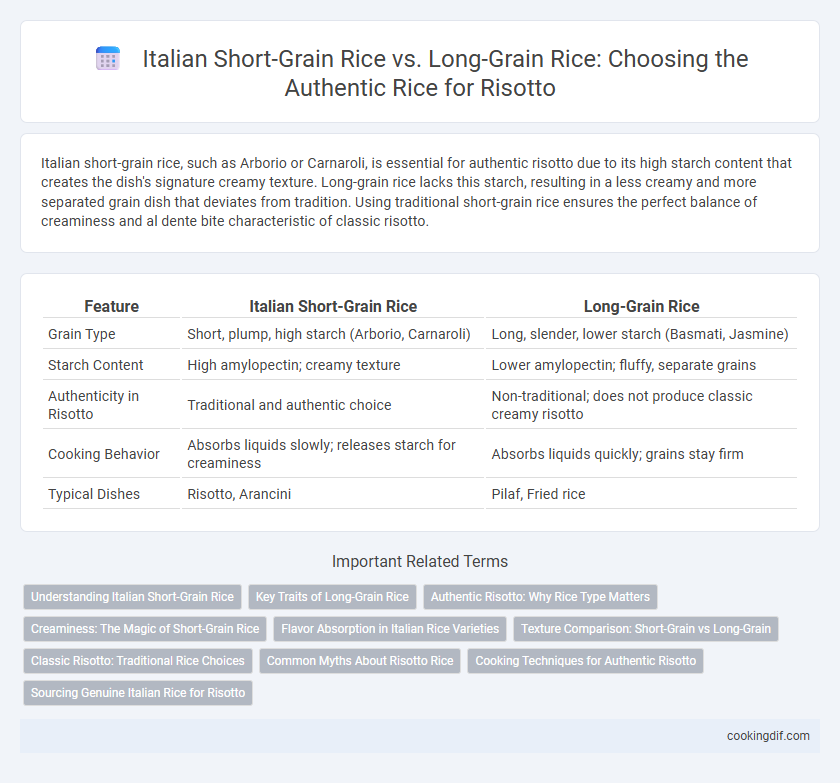Italian short-grain rice, such as Arborio or Carnaroli, is essential for authentic risotto due to its high starch content that creates the dish's signature creamy texture. Long-grain rice lacks this starch, resulting in a less creamy and more separated grain dish that deviates from tradition. Using traditional short-grain rice ensures the perfect balance of creaminess and al dente bite characteristic of classic risotto.
Table of Comparison
| Feature | Italian Short-Grain Rice | Long-Grain Rice |
|---|---|---|
| Grain Type | Short, plump, high starch (Arborio, Carnaroli) | Long, slender, lower starch (Basmati, Jasmine) |
| Starch Content | High amylopectin; creamy texture | Lower amylopectin; fluffy, separate grains |
| Authenticity in Risotto | Traditional and authentic choice | Non-traditional; does not produce classic creamy risotto |
| Cooking Behavior | Absorbs liquids slowly; releases starch for creaminess | Absorbs liquids quickly; grains stay firm |
| Typical Dishes | Risotto, Arancini | Pilaf, Fried rice |
Understanding Italian Short-Grain Rice
Italian short-grain rice varieties such as Arborio, Carnaroli, and Vialone Nano are essential for authentic risotto due to their high starch content and ability to absorb flavors while maintaining a creamy texture. These grains release amylopectin starch during slow cooking, creating the dish's signature rich and velvety consistency that long-grain rice cannot replicate. Using Italian short-grain rice ensures the perfect balance between creaminess and al dente bite, defining traditional risotto's unique culinary experience.
Key Traits of Long-Grain Rice
Long-grain rice, characterized by its slender, elongated kernels, differs significantly from Italian short-grain rice used in traditional risotto. This variety has a lower amylopectin content, resulting in fluffier, less sticky grains that remain separate when cooked, contrasting with the creamy and starchy texture essential to authentic risotto. The unique starch composition of short-grain rice like Arborio or Carnaroli provides the signature creaminess and ability to absorb flavors, which long-grain rice cannot replicate in classic Italian recipes.
Authentic Risotto: Why Rice Type Matters
Authentic risotto relies on Italian short-grain rice varieties such as Arborio, Carnaroli, or Vialone Nano, prized for their high starch content and ability to absorb liquids while maintaining a creamy texture. Long-grain rice lacks the necessary amylopectin starch crucial for the signature velvety consistency, resulting in a drier, less cohesive dish. Choosing genuine Italian short-grain rice ensures the characteristic richness and perfect al dente bite essential to traditional risotto recipes.
Creaminess: The Magic of Short-Grain Rice
Italian short-grain rice, such as Arborio or Carnaroli, is essential for achieving the signature creaminess in authentic risotto due to its high starch content and ability to absorb liquids. Unlike long-grain rice, which remains separate and fluffy, short-grain rice releases amylopectin starch that creates the dish's rich, velvety texture. This natural starch gelatinization is crucial for the traditional silky consistency that defines classic Italian risotto.
Flavor Absorption in Italian Rice Varieties
Italian short-grain rice varieties such as Arborio, Carnaroli, and Vialone Nano are prized for their superior flavor absorption and creamy texture, making them essential for authentic risotto. These varieties have a higher amylopectin content, which releases starch during cooking and intensifies the infusion of broth and seasonings. In contrast, long-grain rice lacks this starch composition, resulting in less absorption and a drier, less flavorful dish.
Texture Comparison: Short-Grain vs Long-Grain
Italian short-grain rice, such as Arborio, cultivates a creamy and tender texture essential for authentic risotto due to its high amylopectin starch content. In contrast, long-grain rice remains separate and fluffy when cooked, lacking the starch release that creates risotto's signature creaminess. The unique creaminess and slight chewiness of short-grain rice ensure the traditional risotto mouthfeel that long-grain varieties cannot replicate.
Classic Risotto: Traditional Rice Choices
Classic risotto relies on Italian short-grain rice varieties such as Arborio, Carnaroli, or Vialone Nano, prized for their high starch content that yields a creamy, velvety texture essential to authentic dishes. Long-grain rice lacks the necessary amylopectin starch, resulting in a drier, less cohesive risotto that deviates from traditional Italian culinary standards. Selecting Italian short-grain rice ensures the classic consistency, flavor absorption, and rich mouthfeel integral to genuine risotto recipes.
Common Myths About Risotto Rice
Italian short-grain rice varieties like Arborio, Carnaroli, and Vialone Nano are essential for authentic risotto due to their high starch content, which creates the creamy texture risotto is known for. Long-grain rice lacks this starch, making it unable to achieve the signature creaminess and firmness balance of traditional Italian risotto. Common myths including using any rice or shortcut methods often lead to a less flavorful and texturally inferior dish, undermining the classic risotto experience.
Cooking Techniques for Authentic Risotto
Italian short-grain rice varieties like Arborio, Carnaroli, and Vialone Nano absorb liquid more effectively and release starch gradually, creating the creamy texture fundamental to authentic risotto. Long-grain rice lacks this starch content, making it unsuitable for the slow, incremental cooking technique that defines traditional risotto preparation. Mastering the gradual addition of warm broth and frequent stirring is essential to coax the rich, velvety consistency characteristic of genuine Italian risotto.
Sourcing Genuine Italian Rice for Risotto
Authentic Italian risotto depends on short-grain rice varieties like Arborio, Carnaroli, and Vialone Nano, cultivated mainly in the Po Valley region for their high starch content and creamy texture. These native Italian grains absorb liquids evenly, ensuring the risotto's signature velvety consistency, unlike long-grain rice which remains separate and dry when cooked. Sourcing genuine Italian rice from reputable producers or DOP-certified areas guarantees traditional quality and preserves the culinary heritage essential to true risotto preparation.
Italian short-grain rice vs long-grain rice for authenticity Infographic

 cookingdif.com
cookingdif.com